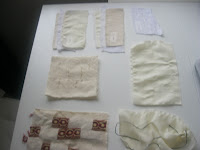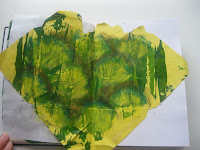Project 5 Stage 3 & 4
Stage 3
By this point I had decided what the design would look like, but I was still unsure of the colour combination that I was going to use or what type of repeat pattern I was going to do with the lino block that I had designed, so I tried a couple of different designs. I first tried layers of complimentary colours, reds and orange and blues and greens and them red, brown and blues. I felt that the red, brown and blue worked better for this sample as, apart from the blue it was the colours that were in my objects that I had drawn. Then I did two different repeat design that i thought worked well with my block print. The first a random, overlaying repeat and then a diamond pattern repeat. They both work well but again for this sample I like the overlaying of the print, as it made interesting patterns when it was overlaid and gave the fabric depth and movement.
Here is my approx 40cm x40cm samples:
Stage 4

Here is my final design. It has 3 different layers of colours rolled on in blocks in different directions horizontally and vertically, I then printed the lino block in two different colours over layering where I felt it worked, I added an extra layer to the design of shading on selected part of the print in Markel paint stick to add to the depth and movement. I am really pleased with it, and feel that I have achieved movement and depth. I love the colours that I chose and feel that they work well together, but I think that any colour combination that works together will work and would give the piece a different feel and mood. I am happy with my chose of fabric, calico. I feel that the weight and texture work well with my design and that a shiny, lightweight or textured fabric would have detracted from the design or it would have lost the texture that I was looking for from the rolled background. I feel that the design works well as the shapes and repeat of the design is simple, which allowed me to overlay the image and colour without it looking to messy.
Reflection from Assignment 2
I really enjoyed this assignment. I felt a little bogged down at the beginning as sewing and embroidery is not my strong point and I do not enjoy it as much as other parts of textiles, but I do think I will use it in some parts of my design work in future. I enjoyed all the drawing, and could have spent hours doing that as well as the printing, I had forgotten how much I enjoyed to do this and would like to do more in the future. I feel that my final print was very successful and that I manage to work thought the design process with ease. My only limitation was finding the time to do it. I did not do much painting on fabric and I did not do the machine embroidery on water soluble fabrics because I ran out of time, but I hope to get round to trying this out. I am looking forward to the next assignment even thought there is more sewing!!

















































